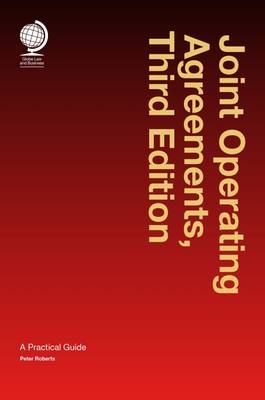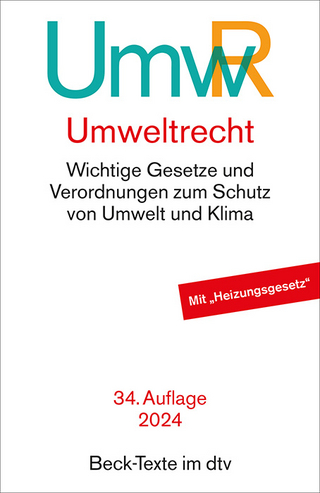
Joint Operating Agreements
Globe Law and Business Ltd (Verlag)
978-1-909416-62-8 (ISBN)
- Titel erscheint in neuer Auflage
- Artikel merken
This third edition of the leading work on joint operating agreements (JOAs) provides a pragmatic examination of the provisions of a typical JOA in the order that they appear, with a particular focus on the critical issues of scope, the operator’s role, joint and exclusive operations, default, transfers and decommissioning. There is also practical analysis of the key issues which apply to the operation of any JOA and the positions which are taken in the various leading industry model form contracts. The perspectives of the operator and non-operator are addressed, along with a consideration of the domestic and international standards which will apply to a petroleum project.
The third edition highlights changes in the JOA world since the second edition and includes three new chapters (with increased focus on incorporated joint venture structures, contracting and forfeiture of interests) and four new appendices (addressing model form JOAs, joint study and bid agreements, the collateralisation of JOAs and the content of JOAs for unconventional petroleum developments).
Author Peter Roberts is the managing partner of the London office of leading US oil and gas law firm Andrews Kurth LLP. He is also the general editor of the Association of International Petroleum Negotiators’ Journal of World Energy Law & Business.
Joint Operating Agreements, 3rd Ed: A Practical Guide is an essential addition to the library of any lawyers, commercial managers, advisers, engineers or financiers who are engaged in the development of petroleum exploration and production projects worldwide.
Introduction 7
Glossary 9
1. First principles 13
1.1 Mineral laws and concessions
1.2 The role of the JOA
1.3 Hybrid concession/JOA structures
1.4 The logic for a joint venture
1.5 Model form contracts
1.6 North American leasehold interests
1.7 Evolution of the JOA
1.8 The JOA’s economic profile
2. Incorporated joint ventures 27
2.1 Introducing the incorporated joint venture
2.2 The role of the shareholder agreement
2.3 Incorporated and unincorporated joint ventures together
3. Duration 35
3.1 Commencement
3.2 Term and termination
3.3 Surviving provisions
3.4 Pre-JOA arrangements
3.5 Chronology of the JOA
4. Parties and participating interests 45
4.1 The parties
4.2 Affiliates
4.3 Participating interests
4.4 Joint property
4.5 State participation
4.6 Carried interests
4.7 Illustrative agreements
5. Scope 57
5.1 Joint operations
5.2 Excluded activities
5.3 Expanding the scope
5.4 Definition of the scope
5.5 Modification of the scope
6. Exclusive operations 69
6.1 Defining exclusive operations
6.2 Exclusive operations mechanics
6.3 Buy-back rights
6.4 Excluding exclusive operations
7. The operator 83
7.1 The operator’s advantage
7.2 Selection of the operator
7.3 The role of the operator
7.4 The locus of the operator
7.5 Removal of the operator
7.6 Hybrid operators
8. The operating committee 101
8.1 The role of the operating committee
8.2 Operating committee mechanics
8.3 Subcommittees
8.4 Voting control
9. Budgets, cashcalls and payments 113
9.1 The funding cycle
9.2 Work programmes and budgets
9.3 Authorities for expenditure
9.4 Cashcalls and invoice requests
9.5 Payment obligations
9.6 Dealing with default
10. Contracting 127
10.1 Procurement options
10.2 Third-party contracts
10.3 Affiliate contracts
10.4 Federal contracts
10.5 Contributions in kind
10.6 Awarding of contracts
11. Petroleum allocation, lifting and disposal 137
11.1 Petroleum allocation
11.2 Petroleum lifting
11.3 Petroleum disposal
11.4 Production-sharing contract allocation
12. Transfers 147
12.1 Transfers under applicable law
12.2 Transfer mechanics in the JOA
12.3 Incomplete transfers
12.4 Pre-emption rights
12.5 Change of control
12.6 Affiliate transfers
13.Withdrawal and surrender 165
13.1 The withdrawal principle
13.2 Reconciling withdrawal with the concession
13.3 The mechanics of withdrawal
13.4 Withdrawal and continuing costs
13.5 Partial withdrawal
13.6 The consequences of withdrawal
13.7 Use of the withdrawal mechanism
14. Liabilities 179
14.1 The operator’s liability to the parties
14.2 Liability allocation between the parties
14.3 Liability for exclusive operations
14.4 Third-party liabilities
14.5 Liabilities and insurance
14.6 General liability
15. Decommissioning 193
15.1 The decommissioning phase
15.2 The regulatory regime
15.3 Collateral support for decommissioning costs
15.4 Decommissioning and the JOA
15.5 Decommissioning on the UK continental shelf
16. Default 207
16.1 Consequence of default
16.2 Definition of default
16.3 Reaction to default
16.4 Remedies for default
16.5 Mortgage and lien protection
16.6 Interest sales
17. Forfeiture 223
17.1 Meaning of forfeiture
17.2 Forfeiture as a penalty
17.3 Relief against forfeiture
17.4 Anti-deprivation
17.5 Forfeiture of the concession
17.6 Forfeiture by any other name
17.7 Withering interest forfeiture
18. Dispute resolution 239
18.1 Dispute resolution principles
18.2 Dialogue
18.3 Expert determination
18.4 Arbitration
18.5 Litigation
18.6 Arbitration or litigation?
18.7 Consolidation
18.8 Confidentiality
18.9 Jurisdiction
18.10 Sovereign immunity
19. Accounting procedure 251
19.1 Model form accounting procedures
19.2 Accounting principles
19.3 Contents of the accounting procedure
19.4 Accounting procedure issues
20. Other provisions 259
20.1 Confidentiality and announcements
20.2 Corporate and social responsibility
20.3 Entire agreement and amendment
20.4 Force majeure
20.5 Governing law
20.6 Health, safety and the environment
20.7 Insurance
20.8 Litigation management
20.9 Notices
20.10 Secondment and teams
20.11 Taxation
20.12 Third-party involvement
20.13 Warranties and representations
Appendices
A: Model form JOAs 281
A1. Industry forms
B: Operator and non- operating party perspectives 285
B1. The operator’s perspective
B2. The non-operating parties’ perspective
B3. Reconciling the operational perspectives
B4. To operate or not
C: The joint study and bid agreement 293
C1. The rationale for a JSBA
C2. Preparing for entry into a JSBA
C3. The content of a JSBA
C4. Migration to a JOA
C5. Exclusivity
C6. Third parties and transfers
C7. Application procedure and voting
C8. Withdrawal
C9. Default
C10. Warranties
D: Partnership and the JOA 301
D1. Definition and consequences of partnership
D2. The JOA as a partnership
E: Farm-outs and the JOA 307
E1. The role of the FOA
E2. Issues with the FOA
F: Unitisation and the JOA 317
F1. The mechanics of unitisation
F2. An example of unitisation
F3. The UUOA and the JOA
G: Subdivisions 329
G1. Subdivision of the concession area
G2. Subdivision of the concession
H: Fiduciary duties and the JOA 333
H1. Defining and applying a fiduciary duty
H2. Fiduciary duties in the JOA
H3. Managing fiduciary duties in the JOA
I: Collateralisation of the JOA 343
I1. The need for collateral support
I2. Collateralisation from the outset
I3. Collateralisation upon a farm-out
I4. Decommissioning security
I5. Exclusive operations
I6. Forms of collateral support
I7. Collateral support across the project lifecycle
J: Unconventional petroleum JOAs 351
J1. Understanding the operational premise
J2. Definition of petroleum
J3. The role of the operator
J4. Defining joint property
J5. Scope
J6. Ongoing project development
J7. Exclusive operations
J8. Withdrawal
J9. Options for petroleum commercialisation
J10. Health, safety and environmental issues, and operator liabilities
J11. Operator liability
J12. Unitisation and joint development opportunities
J13. Decommissioning
About the author 361
Index 363
| Verlagsort | London |
|---|---|
| Sprache | englisch |
| Maße | 160 x 240 mm |
| Gewicht | 730 g |
| Themenwelt | Naturwissenschaften ► Physik / Astronomie |
| Recht / Steuern ► EU / Internationales Recht | |
| Recht / Steuern ► Öffentliches Recht ► Umweltrecht | |
| Technik ► Elektrotechnik / Energietechnik | |
| ISBN-10 | 1-909416-62-2 / 1909416622 |
| ISBN-13 | 978-1-909416-62-8 / 9781909416628 |
| Zustand | Neuware |
| Haben Sie eine Frage zum Produkt? |
aus dem Bereich



